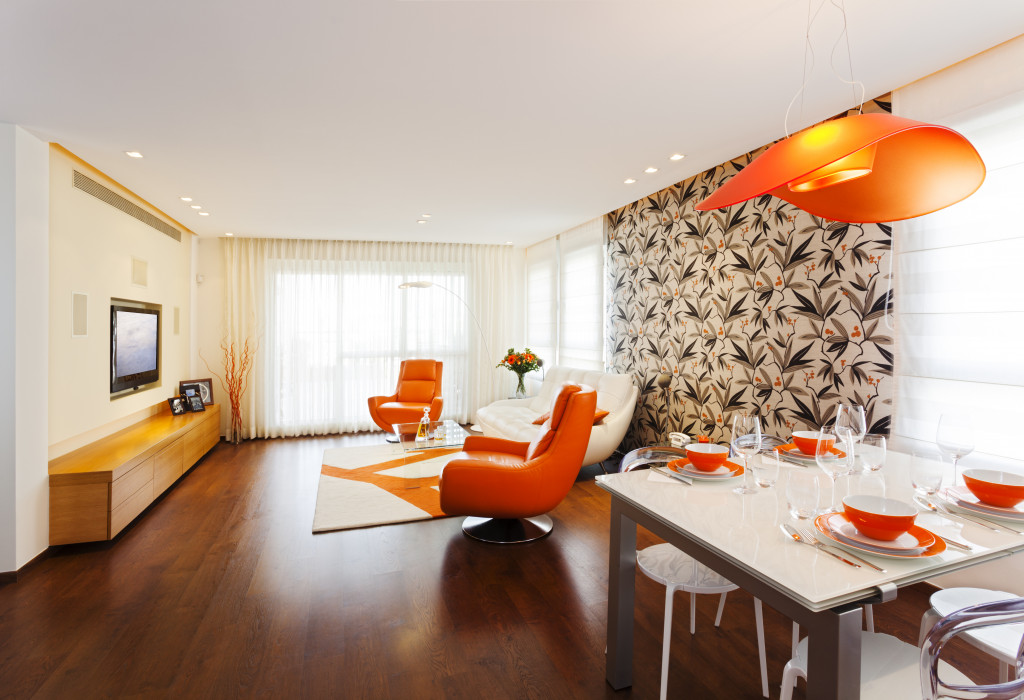- Start home improvements with a clear plan, considering aesthetics, functionality, and budget, and gather the necessary materials.
- Use different layers, textures, and wall art to create an inviting, rich space, and consider installing moldings for depth.
- Utilize different light sources, including natural light, to create a unique atmosphere and highlight specific areas.
- Choose a harmonious color palette to set the mood in each room and invest in high-quality, durable furniture for longevity.
- Be creative and have fun with your design – the possibilities are endless.
There’s nothing quite like coming home to a space that feels inviting, comfortable, and well-designed. Whether you’re looking to increase the value of your property or simply want to create an environment you’ll love spending time in, there are plenty of ways to elevate your home’s interior.
This post will share expert tips for transforming your space into a stunning sanctuary.

Start with a Plan
Before tearing up your flooring or painting your walls, having a clear plan for your space is crucial. Take time to consider the aesthetic you’re going for, the functionality you need, and any special considerations (such as a low budget or small square footage). You can sketch some ideas or make a digital mood board. But the important thing is to have a solid foundation before you begin your home makeover.
Materials and Resources
Once you have your basic concept in mind, it’s time to start gathering materials and resources. Consider where to save money, such as using second-hand furniture or shopping clearance sections for art and accessories. Take notes about your budget so you stay within the budget, and make sure to factor in any additional costs like delivery fees or installation charges. With a detailed plan, you’ll be able to make sure your project stays on track and within budget.
Add Layers and Textures
To create a rich and inviting space, it’s essential to incorporate multiple layers of textures and materials. This includes area rugs, throw pillows, curtains, and decorative objects. Not only will these elements add visual interest, but they’ll also make your space feel more comfortable and cozy.
Wall Art
Additionally, consider adding some wall art or framed photographs to enhance the atmosphere of your room. Even small touches like plants or greenery can help to bring a space alive with life and energy. Remember that when it comes to design, there are no limits! So feel free to be as creative and unique as you’d like.
Install Moldings
You can also install moldings along the bottom or top part of the walls with quarter-round dimensions. This is a great way to add depth and interest to any room. You could even paint the moldings differently than the rest of the walls for added contrast and texture.
Use Lighting Strategically
Lighting can significantly impact the overall look and feel of a room. For a warm and inviting vibe, consider using multiple light sources (such as table lamps, floor lamps, and overhead lighting) that can create a layered and dimmable effect. You can also use accent lighting to highlight artwork or architectural features in your space.
Natural Light
Remember to consider natural light, especially if you have large windows. Natural light can emphasize textures or shapes in the room, such as a cozy chair or painting. You can also use drapes or blinds to filter and soften sunlight.
Cozy Atmosphere
You can also use blinds and curtains to diffuse direct sunlight or create a cozy atmosphere in the evening. Finally, don’t neglect task lighting for your work surfaces—this is especially important for kitchen or home office areas. Using different types of lighting strategically creates a unique and inviting atmosphere in any room.
Consider Your Color Palette
Choosing the right color palette is crucial for creating a harmonious and visually pleasing space. While neutrals like white, grey, and beige are timeless and versatile, don’t be afraid to add pops of color through statement pieces or accent walls.
Mood for Each Room
Consider the mood you want to create in each room and choose colors that support that feeling. For example, greens and blues can evoke a feeling of calmness. At the same time, brighter colors like yellow and orange can create energy. Research color combinations online or consult an interior designer to help pick the perfect shades for your home.

Invest in High-Quality Furniture
Furniture is one of the biggest investments you’ll make in your home decor, so choosing functional and visually appealing pieces is crucial. While you may be tempted to choose affordable options, high-quality items will pay off in the long run. Look for pieces that are well-made, durable, and timeless in design.
Different Options
Purchasing quality furniture doesn’t have to break the bank either, as there are plenty of options at different prices. Researching and shopping around will help you find pieces that fit your budget and style. With the right care, high-quality furniture can last a lifetime and be passed down from generation to generation.
Transforming your home’s interior doesn’t have to be a daunting task. By starting with a solid plan, incorporating layers and textures, strategically using lighting, choosing the right color palette, and investing in high-quality furniture, you’ll be well on your way to creating a stunning space you’ll love spending time in.

